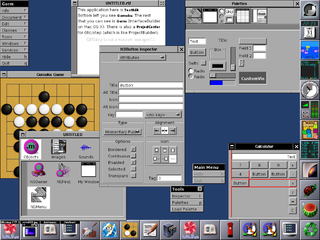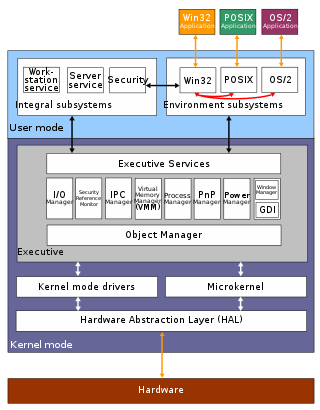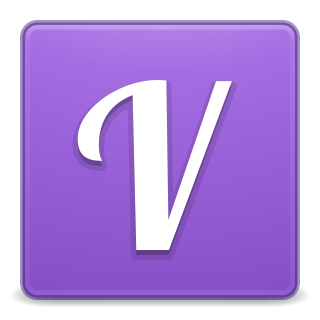Cocoa is Apple's native object-oriented application programming interface (API) for its desktop operating system macOS.

GNUstep is a free software implementation of the Cocoa Objective-C frameworks, widget toolkit, and application development tools for Unix-like operating systems and Microsoft Windows. It is part of the GNU Project.
Carbon was one of two primary C-based application programming interfaces (APIs) developed by Apple for the macOS operating system. Carbon provided a good degree of backward compatibility for programs that ran on Mac OS 8 and 9. Developers could use the Carbon APIs to port (“carbonize”) their “classic” Mac applications and software to the Mac OS X platform with little effort, compared to porting the app to the entirely different Cocoa system, which originated in OPENSTEP. With the release of macOS 10.15 Catalina, the Carbon API was officially discontinued and removed, leaving Cocoa as the sole primary API for developing macOS applications.

The Windows API, informally WinAPI, is the foundational application programming interface (API) that allows a computer program to access the features of the Microsoft Windows operating system in which the program is running. Programs access API functionality via dynamic-link library (DLL) technology.
AppleScript is a scripting language created by Apple Inc. that facilitates automated control over scriptable Mac applications. First introduced in System 7, it is currently included in all versions of macOS as part of a package of system automation tools. The term "AppleScript" may refer to the language itself, to an individual script written in the language, or, informally, to the macOS Open Scripting Architecture that underlies the language.
A cross compiler is a compiler capable of creating executable code for a platform other than the one on which the compiler is running. For example, a compiler that runs on a PC but generates code that runs on Android devices is a cross compiler.

WebObjects is a discontinued Java web application server and a server-based web application framework originally developed by NeXT Software, Inc.
In computer programming, the word trampoline has a number of meanings, and is generally associated with jump instructions.

Delphi is a general-purpose programming language and a software product that uses the Delphi dialect of the Object Pascal programming language and provides an integrated development environment (IDE) for rapid application development of desktop, mobile, web, and console software, currently developed and maintained by Embarcadero Technologies.

Free Pascal Compiler (FPC) is a compiler for the closely related programming-language dialects Pascal and Object Pascal. It is free software released under the GNU General Public License, with exception clauses that allow static linking against its runtime libraries and packages for any purpose in combination with any other software license.

Windows Forms (WinForms) is a free and open-source graphical (GUI) class library included as a part of Microsoft .NET, .NET Framework or Mono, providing a platform to write client applications for desktop, laptop, and tablet PCs. While it is seen as a replacement for the earlier and more complex C++ based Microsoft Foundation Class Library, it does not offer a comparable paradigm and only acts as a platform for the user interface tier in a multi-tier solution.
nesC is a component-based, event-driven programming language used to build applications for the TinyOS platform. TinyOS is an operating environment designed to run on embedded devices used in distributed wireless sensor networks. nesC is built as an extension to the C programming language with components "wired" together to run applications on TinyOS. The name nesC is an abbreviation of "network embedded systems C".

Vala is an object-oriented programming language with a self-hosting compiler that generates C code and uses the GObject system.

AmigaOS is a family of proprietary native operating systems of the Amiga and AmigaOne personal computers. It was developed first by Commodore International and introduced with the launch of the first Amiga, the Amiga 1000, in 1985. Early versions of AmigaOS required the Motorola 68000 series of 16-bit and 32-bit microprocessors. Later versions, after Commodore's demise, were developed by Haage & Partner and then Hyperion Entertainment. A PowerPC microprocessor is required for the most recent release, AmigaOS 4.
RemObjects Software is an American software company founded in 2002 by Alessandro Federici and Marc Hoffman. It develops and offers tools and libraries for software developers on a variety of development platforms, including Embarcadero Delphi, Microsoft .NET, Mono, and Apple's Xcode.
QML is a user interface markup language. It is a declarative language for designing user interface–centric applications. Inline JavaScript code handles imperative aspects. It is associated with Qt Quick, the UI creation kit originally developed by Nokia within the Qt framework. Qt Quick is used for mobile applications where touch input, fluid animations and user experience are crucial. QML is also used with Qt3D to describe a 3D scene and a "frame graph" rendering methodology. A QML document describes a hierarchical object tree. QML modules shipped with Qt include primitive graphical building blocks, modeling components, behavioral components, and more complex controls. These elements can be combined to build components ranging in complexity from simple buttons and sliders, to complete internet-enabled programs.
Mbed is a development platform and operating system for internet-connected devices based on 32-bit ARM Cortex-M microcontrollers. The project was a collaboratively developed by Arm and its technology partners. As of July 2024 Mbed is no longer actively developed by Arm.
Objective-C is a high-level general-purpose, object-oriented programming language that adds Smalltalk-style message passing (messaging) to the C programming language. Originally developed by Brad Cox and Tom Love in the early 1980s, it was selected by NeXT for its NeXTSTEP operating system. Due to Apple macOS’s direct lineage from NeXTSTEP, Objective-C was the standard language used, supported, and promoted by Apple for developing macOS and iOS applications from 1997, when Apple purchased NeXT until the introduction of the Swift language in 2014.
Ark Compiler, also known as ArkCompiler, is a unified compilation and runtime platform that supports joint compilation and running across programming languages and chip platforms, also operating systems of open-source OpenHarmony, Oniro OS, alongside proprietary HarmonyOS with single core system HarmonyOS NEXT included on native APP in Event-driven programming in a unified development environment and formerly built for Android-based EMUI for Huawei smartphones and tablets with HMS-enabled apk apps on AppGallery that improves app performance. It supports a variety of dynamic and static programming languages such as JS, TS, and ArkTS. It is the compilation and runtime base that enables OpenHarmony, Oniro OS alongside HarmonyOS NEXT to run on multiple device forms such as smart devices, mobile phones, PCs, tablets, TVs, automobiles, and wearables. ArkCompiler consists of two parts, compiler toolchain and runtime.
ArkTS is a high-level general-purpose, multi-paradigm, compiled, declarative, static type programming language developed by Huawei which is a superset of open-source TypeScript, in turn a superset of JavaScript formerly used in July 2022 HarmonyOS 3.0 version, alongside its evolved precursor, extended TypeScript (eTS) built for HarmonyOS development as a shift towards declarative programming. ArkTS compiles to machine code via its ahead-of-time compilation Ark Compiler. ArkTS was first released in September 30, 2021 on OpenHarmony, and the ArkTS toolchain has shipped in DevEco Studio since version 3.1, released in 2022. Since, OpenHarmony 4.0 release on October 26, 2023, ArkTS APIs has been added to the open source community to contribute.








